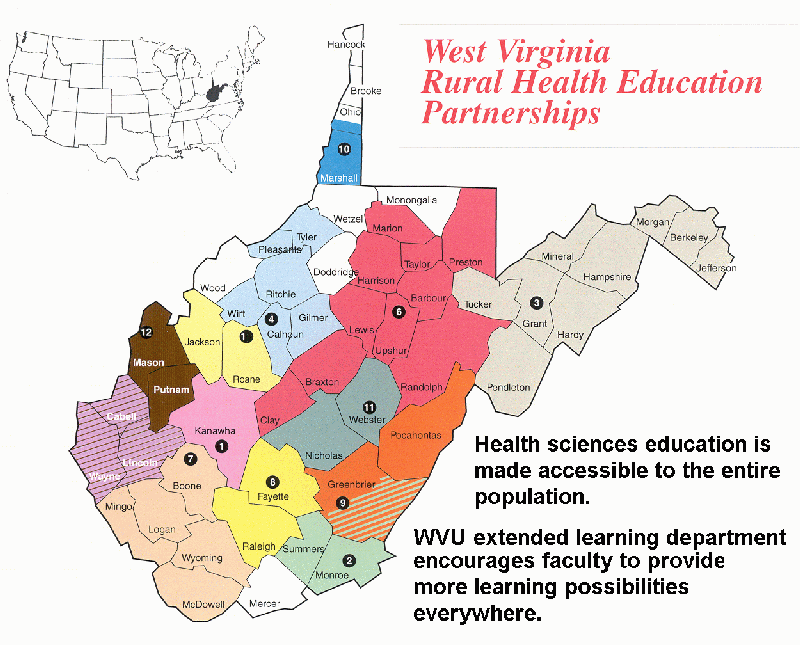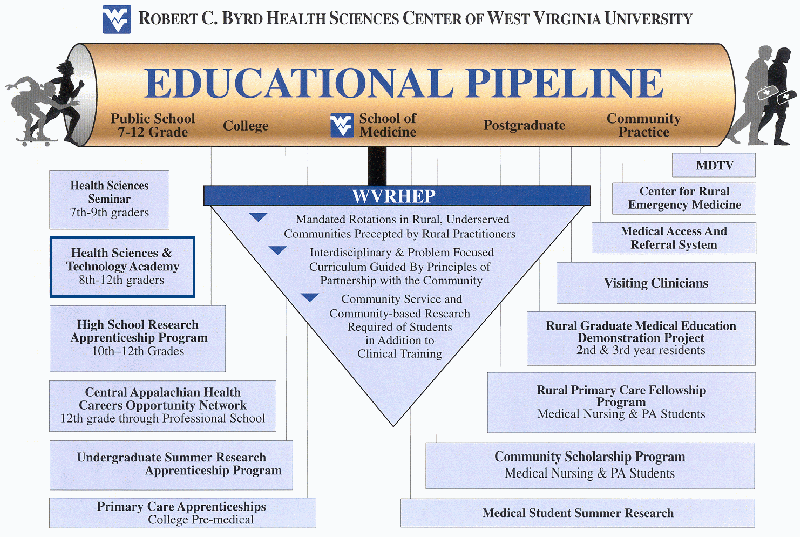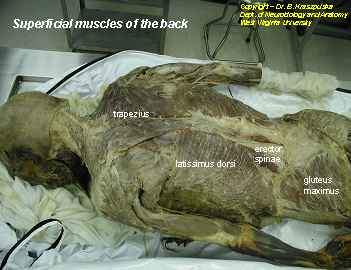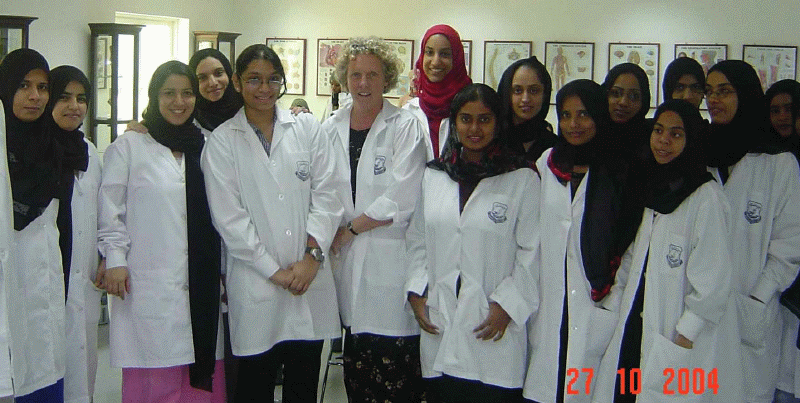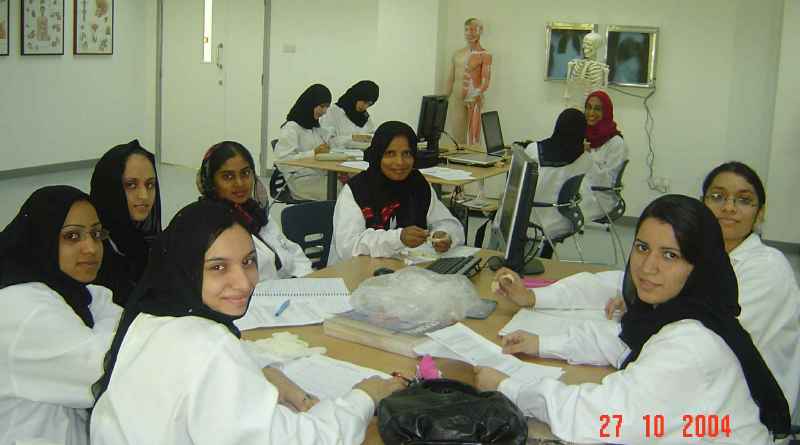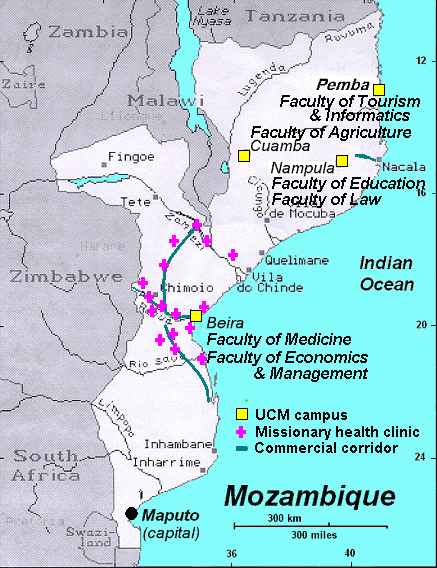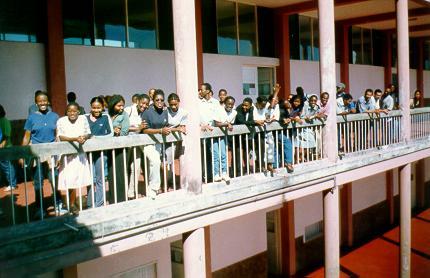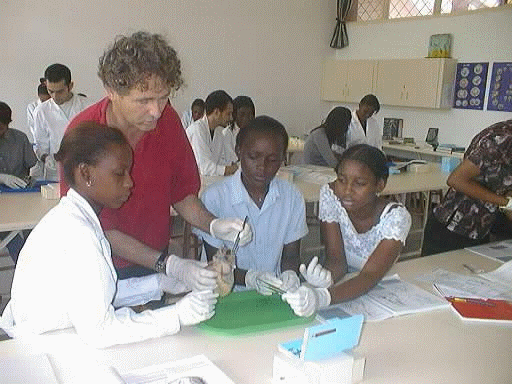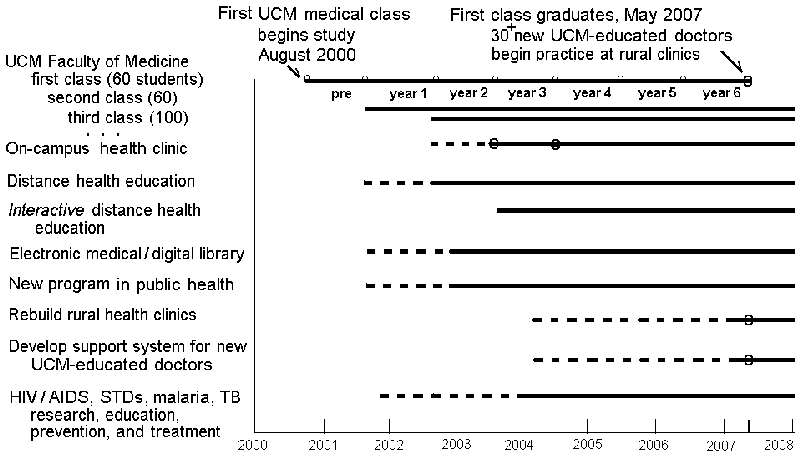|
Health Sciences E- Education: Teaching Virtual Anatomy Labs Elizabeth Walker, Neurobiology and Anatomy, West Virginia University Abstract
West Virginia University (WVU), located in a rural mountainous state in the USA, has developed a rural health education program so that health sciences education can be accessible to the population of the entire state. Figure 1 shows the WV Rural Health Education Partnerships (http://www.wvrhep.org) established to extend health education learning to students and health providers in West Virginia. This program was developed because the mountainous terrain, lack of roads and location of our medical centers in the cities resulted in poor access to health care and education in most of the state. An educational pipeline (Figure 2) was developed drawing students from the entire state, building rural health care centers across the state and incorporating rural health care into all health curricula. University Extended Learning Departments have encouraged the faculty to reach out to distance learners everywhere to provide more learning possibilities.
Online Introductory Human Anatomy Course. In 2001 a general human anatomy course was designed and produced for delivery on the internet. Because undergraduate anatomy courses from the Department of Neurobiology and Anatomy at West Virginia University are reserved for students enrolled in the Health Sciences Center professional schools and allied health programs, each year the Department of Neurobiology and Anatomy turned away100+ students seeking an undergraduate level human anatomy course but not enrolled in these schools. There was a need for an undergraduate introductory human anatomy course. WebCT was chosen to deliver the content over the Internet to the students. A committee was formed that included faculty and technical staff from the Department of Neurobiology and Anatomy to work on the four instructional modules: 1) organization of the body, 2) respiratory and cardiovascular systems, 3) digestive, urinary and reproductive systems, and 4) the nervous system. A good textbook is critical for the success of an online course so we worked closely with publisher Benjamin Cummings and customized their textbook Essentials of Human Anatomy and Physiology, by Elaine Marieb, to contain the content that the students would be responsible for. In addition to the textbook Benjamin and Cummings packaged a CD-ROM that goes along with the textbook and made available online resources including study modules and practice quizzes. The course was successfully offered beginning in 2002. The course has been well received by non-traditional students, and WVU students taking the course in summer session at their homes. Out of state and international students needing a general anatomy prerequisite for more advanced study also take the course.
Virtual Anatomy Lab. At our growing university, the traditional classroom has become very large. Our anatomy department teaches anatomy to nursing, dental hygiene, pharmacy, medical and dental students. Physical and occupational therapy and residents from clinical departments also use the anatomy labs. All registered anatomy students have access to a general anatomy lab, but there is less opportunity for students to have a laboratory experience designed specifically for them. Virtual anatomy lab courses targeted for specific groups of health science students are now under development to fill this need.
Our first asynchronously delivered two credit Virtual Anatomy Lab is designed for physical and occupational therapy, athletic trainers and pre-medical students. Emphasis of this course is limbs and back (Figure 3). The laboratory text and workbook authored by Dr. Julia Guy at Ohio State University is titled Learning Human Anatomy and is available from Prentice Hall Health (3rd ed., ISBN 0-13-143320-2). Because Dr.Guy's undergraduate anatomy classes at Ohio State are very large, she also developed a companion CDROM entitled The Anatomy Lab. This workbook and CDROM enable the student to work independently in learning anatomy before they come to the gross anatomy lab. Our course has web notes, active learning exercises, online testing, and virtual visits to the anatomy lab in addition to the workbook and CDROM assignments. Faculty and the instructional designer employed a modified instructional design process using formative and summative review with feedback from students and other faculty. Active learning techniques were used extensively to increase student interest and participation (Dick W, Carey L., The systematic design of instruction, 3rd ed. Harper Collins Publishing, 1990)
The Virtual Anatomy Lab: Head and Neck will be the next course designed for pre-dental students and other dental disciplines. The combination of the general anatomy course and the Virtual Lab in their area of interest will provide sufficient information to the student or serve as a preparation for higher level anatomy courses i.e. medical, dental, and graduate courses in anatomy.
International Health Sciences E-Education. West Virginia University has a great interest in exploring how open and distance learning and technology-mediated learning can improve the delivery of medical and health education. The university has formal institutional linkages with 66 international institutions and academic groups worldwide. The WVU School of Medicine collaborates with medical schools in Pakistan, China, India, Mexico, Zimbabwe, Mozambique and Oman. The School of Medicine has shared educational expertise and resources with the newly formed International Virtual Medical School (WWW.ivimeds.org), a world-wide virtual medical school with philosophy similar to the Virtual University for Small Island Nations launched by Commonwealth of Learning. This medical school is still under development but plans to serve many countries and students that do not have access to medical education. This approach will be essential to bring about universal access to health education.
Dr. Elizabeth Walker has gained international teaching experience as a Fulbright scholar at Addis Ababa University Faculty of Medicine, Ethiopia; as a Rotary scholar at a new medical school in Mozambique; and as a visiting professor at a new medical school in Oman. These experiences served as a clear reminder that traditional medical schools serve only a few students. However, e-education could serve many qualified students and enable them to complete their desired academic program. Our plan is that WVU anatomy courses and virtual labs will become part of universal medical and health education.
Health Sciences E-Education in Oman. There has been debate about whether it is possible to transplant a complete medical curriculum to new schools such as the Oman Medical College (OMC). Six years ago West Virginia University Health Sciences Center agreed to assist with development and start-up operation of this private college at Sohar in the Sultanate of Oman. It was created with government encouragement to increase output of Omani physicians. WVU is involved in planning and implementing some of the Medical School's first preclinical experiences. Our course, Human Structure and Neurobiology is taught the first semester of medical school.
The initial intention was to “export” our WVU preclinical curriculum, intact, to provide Omani students with a “Western” medical education. Pre-medical students with three years of intensive English and science courses began medical school in the 2004-'05 academic year (Figure 4). We have now concluded our second year of supplying visiting faculty (1-2 month terms) while permanent faculty are recruited and trained.
One key to curricular “transplantation” was transfer of our in-house IT delivery system (SOLE) to Oman, where students with (required) laptops and wireless access can use appropriate curricular materials generated for our WVU courses (or modified any time from any place!). OMC is well equipped for lectures and small group activities and has good IT support but is deficient in lab facilities. Restructuring gross anatomy instruction with much reduced hands-on lab work has been a major challenge. The middle-east has no tradition of human dissection or study of cadavers in the human gross anatomy lab (Figure 5). Creating effective instruction across substantial barriers of language, culture and distance has proven to be a challenge. This medical school would benefit from the use of virtual anatomy labs. Much could be learned in the virtual lab and then reinforced in the real gross anatomy lab.
Health Sciences E-Education in Central Mozambique. The destruction of the rural health system in central Mozambique during 30 years of war has caused the region to be terribly underserved in the provision of basic health care. Infrastructure must be rebuilt, health care personnel trained, public health information gathered and acted upon, education about nutrition, maternal child health, and HIV/AIDS made available to the rural population. The emergence of the Catholic University of Mozambique (UCM) as a significant player in the country's recovery efforts is evident in the success of decentralization of the institutions of higher learning in central and northern Mozambique.
UCM, with a main campus located in Beira, central Mozambique, is the first private university in the country (Figure 6). The location far from the capital city of Maputo means that practically no government assistance is given. The University began in August 1996 with two Faculties: Faculty of Law in Nampula and the Faculty of Economics and Management in Beira. In 1998, UCM opened the Faculty of Education in Nampula and in January 1999, the Faculty of Agriculture (Niassa). In August 2000, UCM initiated the Faculty of Medicine in Beira (Figure 7). And most recently, in 2003, UCM established a Faculty of Tourism and Informatics (Pemba).
The UCM Faculty of Medicine envisions that the physician graduates will be capable of practicing in both rural and urban primary care settings and at small district general hospitals. The graduates must be capable of incorporating public health and preventive medicine practices into their areas of responsibility. An important component of medical student training (Figure 8) will take place in the rural health clinics and hospitals. The mission of the UCM Faculty of Medicine is similar to that of the West Virginia Rural Health Education Partnerships (WVRHEP). They must become life-long learners and teachers/mentors for all their health workers.
The focus is to produce physicians who will be competent to work in rural areas, not just in one to one care but in upgrading the training of health workers in rural areas where this is not readily available. The aim is to open up education from Beira and the Catholic University to the rural areas of Sofala and Manica using distance education technology downloaded to community outreach centers located in the catholic missions. These aims can best be accomplished by distance learning because the distances are enormous, the roads are poor and only a few professionals travel to these rural areas.
Summary of Long Range Distance Education Plan at UCM. The UCM Faculty of Medicine in Beira proposes the establishment of long distance medical education/ continuing medical education for physicians, nurses and other health workers in northern and central regions of the country (Figure 9). The backbone of the project is a new distance medical education center at the Faculty of Medicine including studio/ electronic classroom, medical education laboratory, and full-time connection to the Internet. The center will coordinate preparation and delivery of long distance courses, short-courses, workshops, tutorials and other web-based materials using WebCT, or similar course management software. Students and professionals will be able to receive their education at the six campuses and sixteen (16) rural clinics/outreach centers set up at Catholic Missions/ Schools located along the main travel corridor between Beira and Zimbabwe. Each of these long distance education outreach centers will have approximately eight computers, a full-time Internet connection, and help provided by a technical assistant.
However, at this time, Mozambique remains internet-poor with only 255 public internet protocol (IP) addresses (needed for web servers) for the entire country. Most of these addresses are utilized in the capital city, Maputo. None are available to the central and northern part of the country or to any of the UCM campuses. Telephone service is available in cities. The strategy will be to install two-way satellite internet systems, with public IP addresses coming from the European company providing the service.
Figure 9 shows current progress and future projects underway at UCM Faculty of Medicine. Planning for these activities began during a Partnership for rural health education, USAID-ALO award, 2001-2003, with West Virginia University. A successful rural health program in West Virginia served as a partial model. The project supported travel by UCM and WVU professors as they jointly develop projects/ proposals on medical education, rural health, public health, and HIV/AIDS.
Pilot Rural Clinic. The first pilot Rural Clinic is located in Mangunde at a Catholic mission in a remote rural area, in the district of Chibabava. This is the only rural clinic in Mozambique that also treats HIV/AIDS, and it was featured in an article in SLATE magazine (www.slate.com/id/2119853/entry/2119968/). Mangunde is 303 km away from the city of Beira, in a rural area around 4 ½ hours driving time over roads that are marginal in many sections. When the project was started, there were only two HIV clinics in the Beira area, both in Beira city: one run by the government and one by the Catholic lay organization.
This new rural clinic is equipped with 16 solar panels to power some equipment, but not enough to power all the medical and computer systems. So a back-up generator had to be bought and runs most of the days. Solar panels are, however, very important to save fuel during the days when there are no medical visits and when often it is not required that all the computers be on at the same time. The clinic is well-equipped with 2 LAN servers and 5 computers (one each in the exam room, pharmacy, acceptance desk, doctor's office and blood collection areas), 2 deskjet printers (laser printers consume a lot more energy) and 1 solar energy-powered refrigerator to store medications. It should be noted that the Chibabava District does not have electricity from the grid, or telephones. Funding for infrastructure improvement has not kept pace with the original plans.
Conclusion. Virtual anatomy lab courses are designed for specific groups of health science students. These labs are most beneficial as introductory courses for beginning anatomy students. Even medical students can benefit from the virtual lab as an initial experience, followed with hands-on work in the gross anatomy lab. The challenge is to provide virtual labs that would be equivalent to traditional hands-on gross anatomy labs and could be offered as distance courses.
Figures |
